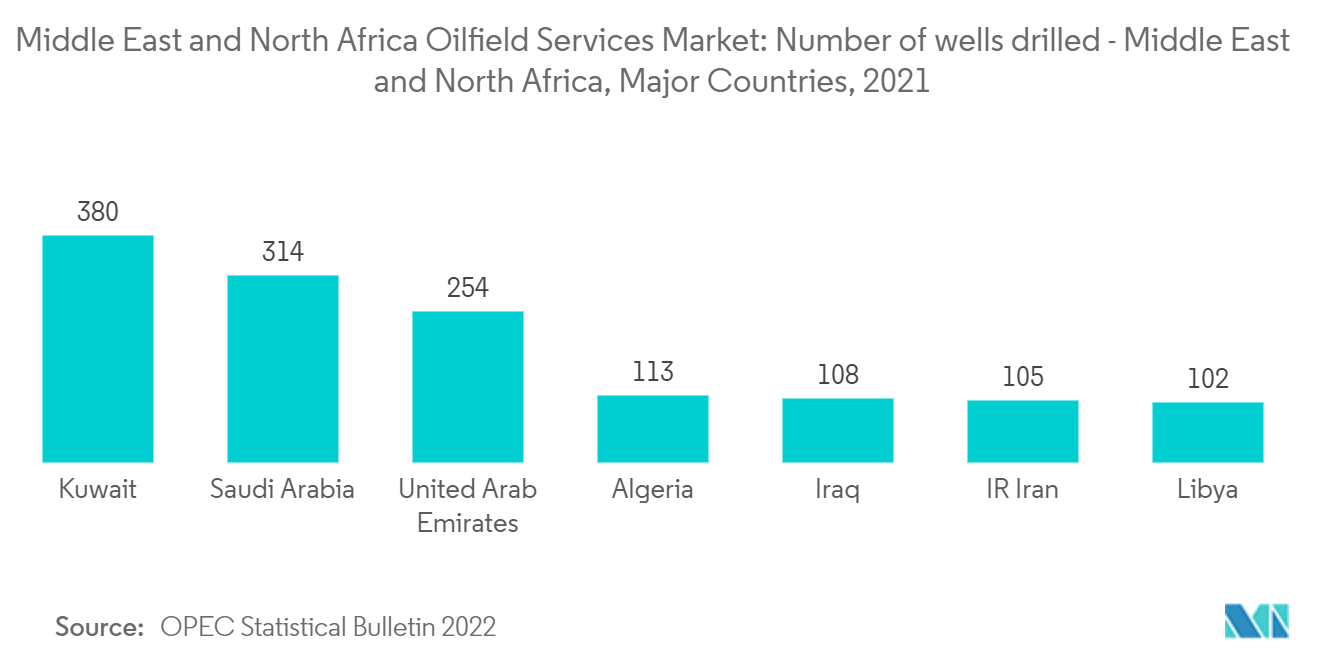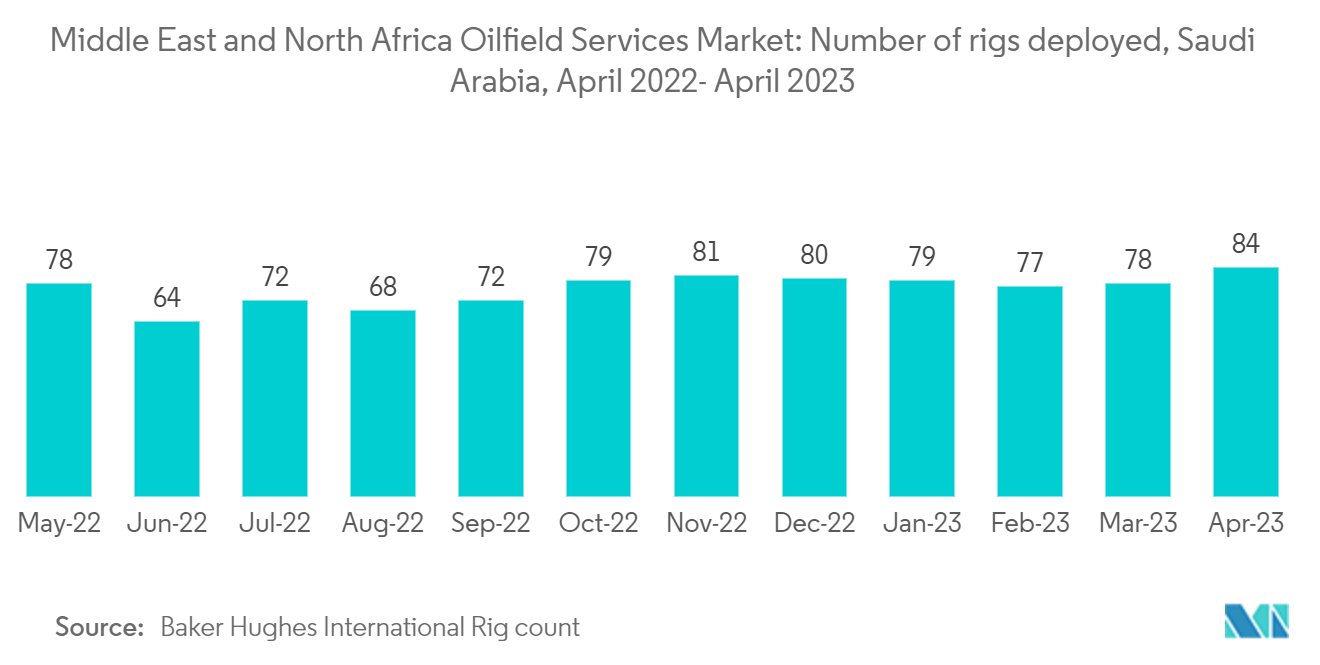Market Trends of Middle East And North Africa Oilfield Services Industry
Drilling Segment to dominate the market
- Drilling is one of the the most cost-intensive parts of the entire Exploration and Production (E&P) phase, and as new wells are being drilled. According to most industry estimates, drilling accounts for more than 70% of the total well costs, and hence, drilling services are expected to constitute a major part of the market revenues.
- The Middle-East and North Africa is a major global hotspot for the oil and gas upstream sector, and a signficant share of wells drilled globally are in the region. and it is estimated that nearly, during 2021, nearly 1400 wells were drilled in the region, representing nearly 2.7% of the total number of wells drilled globally during 2021.
- Similarly, according to the International Rig Count, as of September 2022, nearly 342 rigs were deployed in the Middle East and North Africa Region, accounting for nearly 38.9% of the total number of rigs deployed globally.
- Additionally, as most of the countries in the region are heavily dependent on hydrocarbon revenues to power their economies, the countries in these regions were heavily affected by the Covid-19 pandemic, as demand fell due to economic impacts of the pandemic. However, as demand hras recovered in the post-pandemic period, combined with the economic fallout of the Russia-Ukraine War, hydrocarbon prices have spiked globally. Hence, to profit from the high prices, these countries are investing heavily in expanding production capacity to rake in higher oil revenues. This is expected to result in higher investments in the E&P sector, driving the drilling segment during the forecast period.
- For instance, in the United Arab Emirates, to accelerate the expansion of production capacity, the state-owned oil and gas utility, ADNOC has been fast-tracking the development of several major projects, which primarily include some of the largest offshore fields in Abu Dhabi. ADNOC has declared that over the period of 2022-2026, it aims to invest nearly USD 127 billion on growth projects, and it is expected that over the upcoming 2 years, ADNOC is set to offer multiple engineering, procurement and construction contracts. The company has already made significant long-term investments in the sector, and the trend is expected to continue during the forecast period, driving the sector's growth and demand for oilfield and well equipment.
- For instance, in August 2022, the company offered 5 framework agreements to major oilfield services companies which include Al Ghaith Oilfield Supplies and Services Company, Al Mansoori Directional Drilling Services (Al Mansoori), Schlumberger Middle East S.A (Schlumberger), Haliburton Worldwide Limited Abu Dhabi (Haliburton) and Weatherford Bin Hamoodah Company LLC (Weatherford). These framework agreements are for directional drilling and logging while drilling (LWD) services for both onshore and offshore assets, and will run for 5 years, with an option of extending the contracts for 2 more years.
- As the Middle East and North Africa region is expected to be a major hotspot for drilling activities, the drilling segment is expected to dominate the matket during the forecast period.

Saudi Arabia to dominate the market
- Saudi Arabia is the largest crude oil producer in the MENA region, and the country has been a global leader in upstream technology. According to the Saudi Ministry of Energy, the country produced 9124.72 thousand barrels/day of crude during 2021, making it the 3rd largest producer of crude oil, and during 2021, the country produced 120.46 billion cubic m of gas, making it the 8th largest producer globally.
- The country is the largest producer of crude oil in the MENA region and has the second largest proven crude oil reserves globally. The country's E&P sector is dominated by the state-owned hydrocarbon utility Saudi Aramco, the world's largest exporter of crude oil.
- Saudi Arabia is one of the most influential members of the OPEC cartel, and since the COVID-19 pandemic decimated energy demand globally, the country has been slowly raising production quotas to keep oil prices stable globally.
- The country's upstream sector is focused on the development on massive limestone reservoirs in the country's onshore and offshore areas such as the world's largest conventional onshore oil field (Ghawar) and the largest conventional offshore field (Safaniyah). These colossal fields have been producing for a long time, and still have significant recoverable reserves. Additionally, Saudi Arabia has also started the development of the Jafurah Shale play, the country's largest unconventional shale play, estimated to hold nearly 200 Trillion cubic feet of shale gas.
- Drilling and completion of new wells is a significant investment; however, Saudi Arabia has one of the lowest cost of drilling globally. According to Saudi Aramco, the average upstream lifting cost was SAR 11.3 (USD 3) per barrel produced in both 2021 and 2020.
- Saudi Aramco has disclosed plans to boost its capital expenditure (CAPEX) to USD 40-50 billion in 2022, up by nearly 50% from 2021, with further growth expected until 2025. The company plans to increase its crude production capacity to 13 million barrels/day by 2027 and aims to increase gas production by nearly 50% by 2030.
- Such ambitious expansion plans, coupled with new-age goals of complying with sustainability and environmental standards, is expected to attract significant investments and require major innovation in the sector, factors which are expected to drive the upstream market in the country, and the demand for oilfield services in the country during the forecast period.


